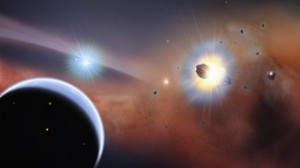Podcaster: Richard Drumm
Title: Space Scoop: Health Warning for a Nearby Star
Organization: Astrosphere New Media
Link : astrosphere.org ; http://unawe.org/kids/unawe1409/
Description: Space scoop, news for children.
Bio: Richard Drumm is President of the Charlottesville Astronomical Society and President of 3D – Drumm Digital Design, a video production company with clients such as Kodak, Xerox and GlaxoSmithKline Pharmaceuticals. He was an observer with the UVa Parallax Program at McCormick Observatory in 1981 & 1982. He has found that his greatest passion in life is public outreach astronomy and he pursues it at every opportunity.
Today’s sponsor: This episode of “365 Days of Astronomy” is sponsored by — no one. We still need sponsors for many days in 2013, so please consider sponsoring a day or two. Just click on the “Donate” button on the lower left side of this webpage, or contact us at signup@365daysofastronomy.org.
Transcript:
This is 365 Days of Astronomy. Today we bring you a new episode in our Space Scoop Series. This show is produced in collaboration with Universe Awareness, a program that strives to inspire every child with our wonderful cosmos.

New observations of the nearby star Beta Pictoris show that the disc contains lots of carbon monoxide gas. The gas is being constantly delivered by comets, asteroids and small planets as they crash into each other and shatter apart.
Credit: NASA’s Goddard Space Flight Center/F. Reddy
From the comfort of our day-to-day lives, it often feels like space is very far away. But when you think about it, Earth is part of space.
Our planet is spinning through space with all the other planets, stars and even galaxies.
It is even made from the same basic materials or “matter” – baryonic matter specifically – as everything else, which is why we find the same materials out in space as we do right here at home.
Astronomers have just spotted large amounts of one of these materials, a gaseous molecule called carbon monoxide, around a nearby star called Beta Pictoris.
That’s right. It’s the same Beta Pictoris or BetaPic that I talked about last month, the one with a “Super Earth” exoplanet whose rotation rate of 8.1 hours has been calculated!
Carbon monoxide or CO, is a chemical we see on Earth and is created when certain things burn, but burn incompletely, like forest fires and volcanoes, and also in internal combustion engines. With complete combustion you get CO2, an extra Oxygen atom attaches itself to the molecule.
Beta Pic is surrounded by a large disc of cosmic gas & dust which has that super Earth exoplanet inside it. It’s from this dusty disc that the planet formed.
New observations show that the disc contains lots of CO gas. But why is this interesting? Well, this gas is easily and quickly destroyed by starlight.
So where did it come from and why hasn’t it been burned away?
Astronomers believe that the CO is being constantly delivered by comets & asteroids & small planets within the dusty disc.
All of these must contain large amounts frozen CO which is deposited into the disc when these objects crash into each other and shatter.
Like water, carbon monoxide can exist in different forms. Inside the comets and asteroids it is frozen solid, the way water turns into ice when it’s very cold outside.
Out in the disc the CO is a gas, similar to the steam we see rising from hot drinks.
Like water, CO even has a liquid phase. It has to be -192*Centigrade or -314*F to condense. It freezes at -199*C or -326*F. So there’s only a 12 Farenheit-degree-wide window where it’s liquid!
To supply the gas that we see around Beta Pic, one big comet must be completely destroyed every five minutes! That’s a lot of comets!
Cool Fact: It’s lucky for us this cloud of carbon monoxide was found so far away from Earth, as too much of this stuff is poisonous to humans and animals! Yikes!
Thank you for listening!
365 Days of Astronomy is a community podcast made possible thanks to the contributions of people like you. Please consider donating at 365DaysofAstronomy.org/Donate
End of podcast:
365 Days of Astronomy
=====================
The 365 Days of Astronomy Podcast is produced by Astrosphere New Media. Audio post-production by Richard Drumm. Bandwidth donated by libsyn.com and wizzard media. You may reproduce and distribute this audio for non-commercial purposes. Please consider supporting the podcast with a few dollars (or Euros!). Visit us on the web at 365DaysOfAstronomy.org or email us at info@365DaysOfAstronomy.org. In the new year the 365 Days of Astronomy project will be something different than before….Until then…goodbye

